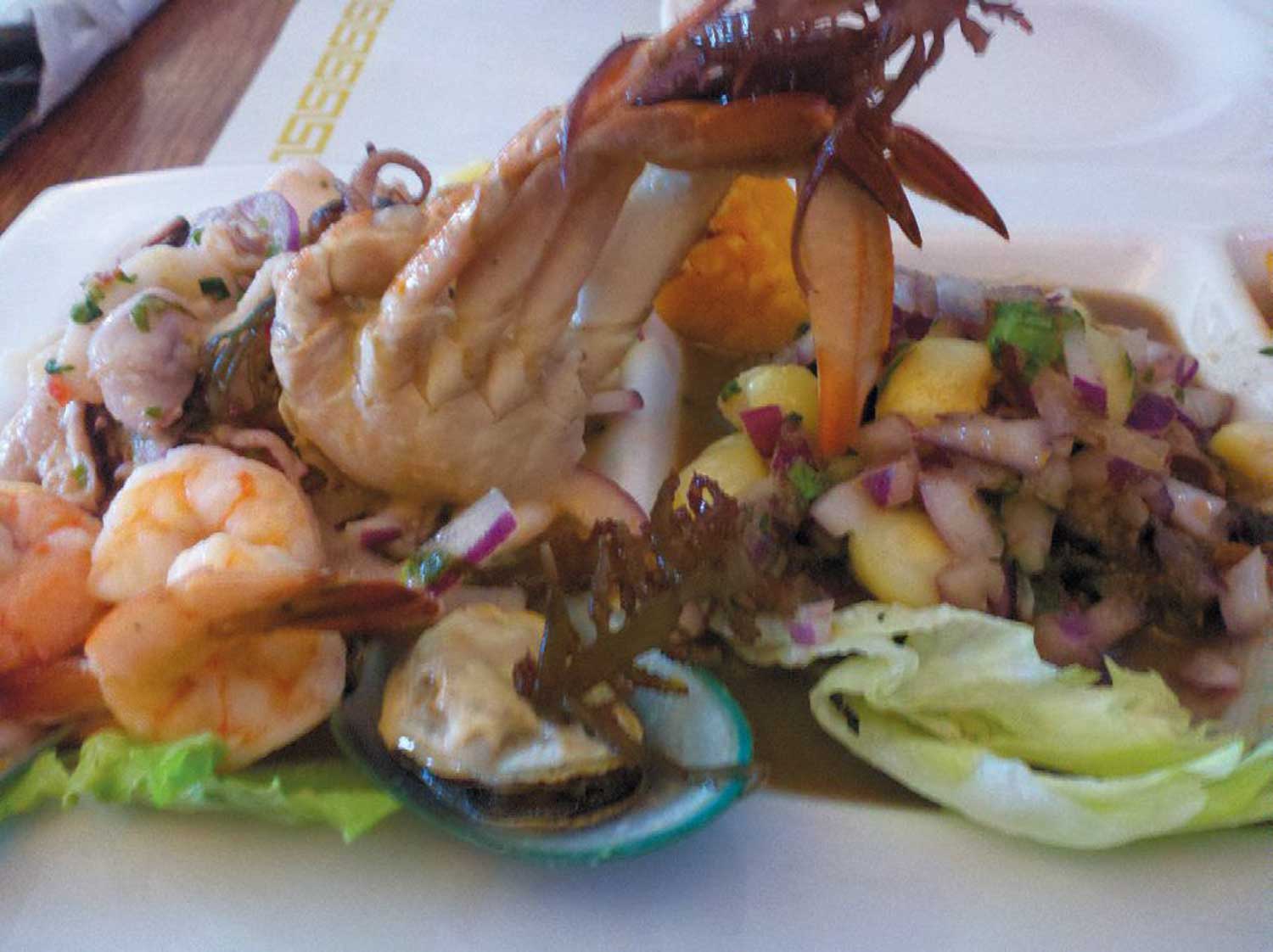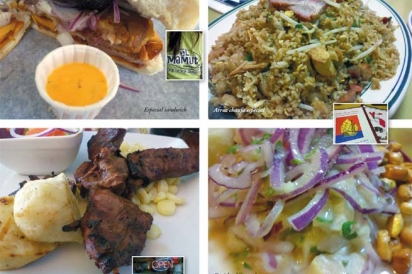Food Georgraphy: New Jersey's Inca Trail
Great Peruvian food, no mountain climbing required
You do not have to traverse the Andes or fly to Lima to sample one of the world’s finest, most diverse cuisines: Peruvian food. New Jersey might be one of the best places outside of Peru to eat it.
Fresh seafood, grilled meats, Chinese-influenced rice dishes, Japanese-inspired ceviches, complex sauces and seemingly endless potato varieties make Peruvian one of the world’s most diverse, distinctive, and delicious cuisines. Five hundred years in the making, Peruvian menus blend indigenous foods cultivated by the ancient Incas—corn, potatoes, chilies—with the ingredients and techniques imported by waves of European, African and Asian immigrants. Signature Peruvian dishes offer something for every taste.
Peru has been getting a lot of global attention lately from the food press and celebrity chefs. None other than gastronomic guru Ferran Adrià, whose restaurant El Bulli was considered by many to be the world’s best before it closed to the public in 2011, declared, “The future of gastronomy is being cooked up in Peru.” Adrià has announced plans to open a Japanese-Peruvian fusion restaurant in Barcelona and recently collaborated with Peru’s most famous chef, Gastón Acurio, on a Peruvian food documentary. Acurio, who owns dozens of restaurants in Peru and around the world, opened his first New York cebicheria, La Mar, two years ago.
Foodies are just catching up to a cuisine we have had in our midst for a while. New Jersey is home to multiple first-generation Peruvian- American neighborhoods with no-frills restaurants serving cheap and delicious Peruvian food primarily to local customers. You can eat strong versions of every signature Peruvian dish in the Garden State —except for the traditional Andean cuy (guinea pig), which I have yet to see on a Jersey menu.
New Jersey’s Inca Trail runs through North Jersey’s historically industrial towns where Latino immigrants are revitalizing blue-collar neighborhoods. All of these restaurants are very affordable—you can generally feed a family of five, with plenty of leftovers, for less than $60. You are unlikely to glimpse magnificent Andean cloud forests or the ruins of any 15th-century civilizations, but you will enjoy wonderful food.
Start your expedition in Hudson County, home to three of the communities in the United States with the highest percentage of residents claiming Peruvian ancestry (East Newark, Harrison and Kearny). Oh! Calamares (102 Kearny Avenue, Kearny) is a popular neighborhood spot with a full bar, so you can start your meal sipping a Pisco Sour, the Peruvian national cocktail made with grape brandy (pisco), frothy egg whites and a dash of bitters. Treat the kids to an Inka Kola, the popular Peruvian soft drink that tastes like Mountain Dew with a hint of bubble gum. Choritos a la chalaca, mussels topped with vinegar-marinated onions and Peruvian large-kernel corn, are a nice twist on traditional ceviche. Picante de mariscos is a delicious bowl of shellfish in a creamy sauce flavored with ají amarillo, the yellow Peruvian pepper used in many dishes. The best known Peruvian potato dish is papas a la huancaina—sliced potatoes garnished with olives and hard-boiled eggs, coated in a cool, bright yellow cheese sauce mildly spiced with ají amarillo, Oh! Calamares makes a very good huancaina sauce. I prefer the spicier versions, and like it on fried yuca better than over boiled potatoes. So head north into Bergen County to Rutherford’s Sabor Peru (8 Highland Cross, Rutherford) for an excellent yuca a la huancaina. Their heaping plate of Peruvian fried rice—chaufa—is also worth the trip.
Cross the Passaic River for Peruvian food in the heart of New Jersey’s Peruvian community. Passaic County is home to the largest Peruvian population in the state, a Peruvian Consulate in Paterson, and dozens of Peruvian eateries. The annual Peruvian Parade in July attracts 30,000 participants to the streets of Paterson, Clifton and Passaic. According to Haledon Councilwoman Belgica Costa, a first generation Peruvian-American who grew up outside of Trujillo in Northern Peru, the Parade and festival is a good opportunity to sample Peruvian treats like picarones (squash and sweet potato doughnuts covered in syrup) and mazamora morada (a purple corn pudding). Costa recommends Clifton’s Aji Limon (1239 Main Avenue) for one of her favorite dishes, pescado a lo macho, a fish fillet served in a creamy seafood sauce.
If you like rotisserie chicken, you’ll love the Peruvian version. Peruvian cooks marinate the chicken in vinegar and spices, often overnight, before roasting. Pollo a la brasa, done right, has a crisp skin, with juicy flavorful meat throughout. El Chevere (603 Main Avenue, Passaic) is the place to order a whole or half chicken a la brasa, the house specialty. The restaurant offers a comfortable, family friendly dining room in downtown Passaic. There is a full menu of Peruvian standards, including anticuchos, the popular Peruvian street food. Adventurous eaters can try grilled skewers of marinated organ meats like beef hearts, chicken livers gizzards (mollejitas), chicken hearts, pork stomach (pancita) or tripe (rachi).
Peruvian dining can be very healthy, with the abundance of seafood and nutrient-rich grains like quinoa. It can also be downright decadent, given the many fried foods and rich cheese sauces. One of the more heart unhealthy, but delicious sandwiches I’ve eaten is served at El Mamut (22 Broadway, Passaic), a tiny café and lunch counter. The “Especial” is a large soft bun filled with thick slices of fresh roasted pork, blood sausage, sliced yams and pickled red onions. Pour on the homemade rocoto chili sauce for a nice spicy kick. The “Wooly Mammoth” name and logo might be a nod to the size of all of their sandwiches, which include a pork rind sandwich and a hamburger topped with egg, bacon and cheese. Nothing on the menu costs more than $7. The line of people waiting for a seat on Saturdays often goes out the door.
For the next stop on New Jersey’s Inca Trail, hop on Route 80 and drive west all the way to Morris County. Dover is one of thirteen majority Hispanic municipalities in New Jersey according to the 2010 Census. Its Peruvian community eats well. El Marino (130 Mt. Hope Road, Dover), which sits unobtrusively in a residential neighborhood above downtown Dover, might be serving some of the best Peruvian food in New Jersey. The restaurant doesn’t need the endearing sign in the window—“Authenticates Peruvian Food”—to confirm the authenticity of its cuisine. Just look at the packed tables on a weekend afternoon. El Marino celebrates Peruvian seafood, with a menu emphasizing seafood soups like chupe de camarones—shrimp bisque served with poached eggs, fish and shellfish entrees —fried, stewed and with rice, and ten different ceviches.
Peruvians are justifiably proud of their many ceviche variations— raw fish marinated and “cooked” in lemon or lime juice, flavored with chilies. Ceviche de pescado (fish), mixto (with shellfish) and de camarones (shrimp) are typically served with sweet potato, large kernel Peruvian corn (choclo), and a scattering of pickled red onions. Tiraditos are thin fish slices, like sashimi, prepared the same way. In spicier versions, the ceviche marinating liquid, leche de tigre (tiger milk), can be ordered as a drink thought to cure hangovers. The Ceviche Trio at El Marino is the best ceviche I have eaten in New Jersey, an impressive plate brimming with fish, black clams (conchas negras) and assorted shellfish, all bathed in a spicy lemon broth, surrounded by boiled choclo, red onion slices, sweet potato chunks and seaweed. The fish is fresh and the flavors are spot-on Peruvian ceviche at its best. El Marino’s arroz chaufa mixta is also excellent, a large plate of soy sauce-flavored fried rice with substantial pieces of beef and chicken, green onions, scrambled egg, and, in a nice flourish, topped with pieces of toasted wonton skin. The portions are large—a ceviche and arroz chaufa alone can feed four people easily. In downtown Dover, another Peruvian spot—Las Tres Marias (88 North Sussex Street, Dover)—serves the best chicha morada, a purple corn drink flavored with cloves and cinnamon.
Turn back southeast and venture into Union County to find more Peruvian food in Elizabeth, New Jersey’s fourth largest city. Don Julio (50 Marshall Street, Elizabeth), a neighborhood restaurant facing the Elizabeth waterfront, is the perfect place to sample Peruvian “chifa” (from the Mandarin “to eat rice”) cuisine. Chinese-influenced Peruvian specialties like arroz chaufa, lomo saltado (stir fried beef ) and tallarines (noodles) are served family-style. Don Julio has two separate menus, the “Peruvian” and the “Chifa.” From the latter, you can choose from eight versions of chaufa—shellfish, shrimp, chicken, beef, roast pork, Chinese sausage, vegetable, or my favorite, the Chaufa Especial, which shows up with a little bit of everything. The cafeteria-style dining room in the back of the restaurant fills with large families. The wonton soup, for six people, arrives at your table in one huge bowl.
Our final stop is in Essex County, where there is yet another cluster of no-frills Peruvian restaurants in West Orange. I recommend Misty’s (277 Main Street), where there is a wall mural of Machu Picchu, complete with Inca warriors, and another good yuca a la huancaina.
Our Peruvian food tour, however, ends a few miles away in Montclair, a decidedly upscale restaurant town without a sizeable Peruvian- American population. Anticipating the global trend, New Jersey now boasts fancier Peruvian spots like Costanera (511 Bloomfield Avenue, Montclair) that are introducing Peruvian cuisine to new audiences. A sleek dining destination, Costanera’s menu is more limited, the plates are smaller, and prices are higher than the typical Jersey Peruvian spot, but the core ingredients and Peruvian flavors are the same, with excellent ceviches, causas (mashed potato salads) and arroz chaufa. Before opening Costanera in 2010, chef Juan Placencia had trained at the Culinary Institute of America and cooked in the kitchens of Jean-Georges Vongerichten and Tom Colicchio, but he learned the New Jersey-Peruvian restaurant business at his parents’ restaurant, Oh! Calamares in Kearny.
If the history of New Jersey ethnic restaurants is any guide, Costanera may signal a coming wave of Peruvian restaurants that will bring Peruvian food from traditionally Peruvian-American neighborhoods into the rest of New Jersey. From Passaic, from Dover, or from Elizabeth, who knows where the next generation of Peruvian restaurateurs will set up shop? For fans of global cuisine in New Jersey, this is a very good thing.
For more adventures in New Jersey’s ethnic food geography, visit Ethnic NJ.
Ten Spots to Find New Jersey’s Best Peruvian Food
- Aji Limon | 1239 Main Avenue, Clifton 973.272.3659
- Costanera | 511 Bloomfi eld Avenue, Montclair 973.337.8289
- Cucharamama | 233 Clinton Street, Hoboken 201.420.1700
Maricel Presilla’s creative, upscale pan-Latino menu includes Peruvian anticuchos, ceviche, and picante de camarones (shrimp in spicy pepper sauce). - Don Julio | 50 Marshall Street, Elizabeth 908.820.0100
- El Chevere | 603 Main Avenue, Passaic 973.458.8308
- El Mamut | 22 Broadway, Passaic 973.777.2001
- El Marino | 130 Mt. Hope Road, Dover 973.659.0402
- Oh! Calamares | 102 Kearny Avenue, Kearny 201.998.4111
- Planet Chicken | 107 North Washington Avenue, Dunellen 732.424.3424
The owners started selling pollos a la brasa from a food cart. The chicken was so popular, they opened this restaurant. - Sabor Peru | 8 Highland Cross, Rutherford 201.935.7378







